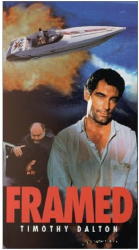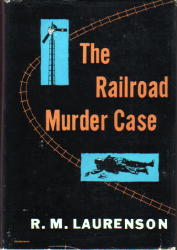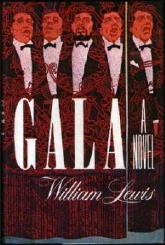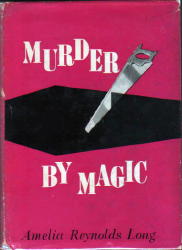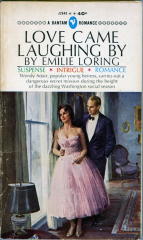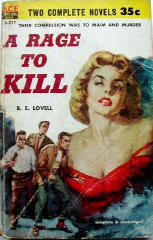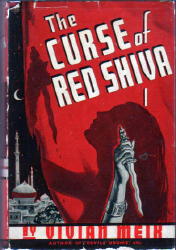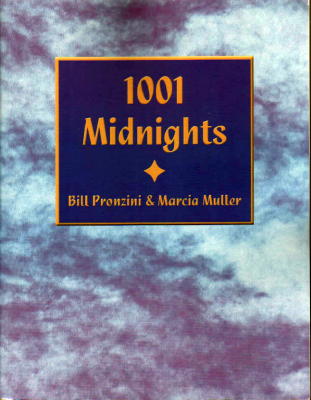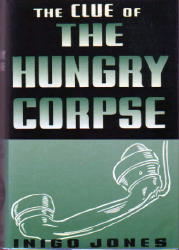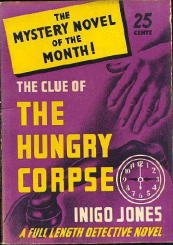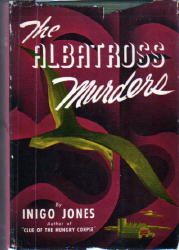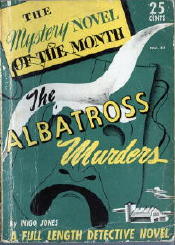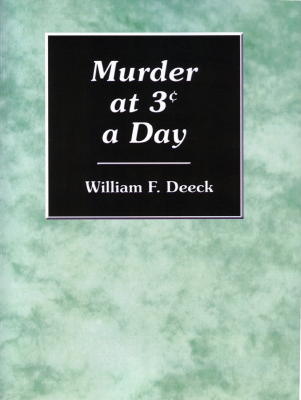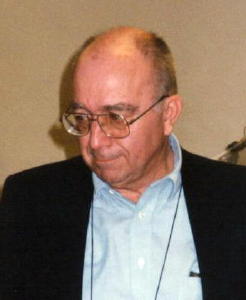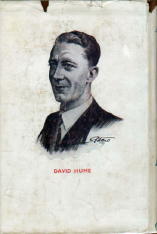Al Hubin is now working on Part 16 of his Addenda to the Revised Crime Fiction IV; if you follow the link, the first 15 are now online. I’m still working on Part 3, adding images, commentary and various links. Here are most of the L’s, which I’ve finished up recently:
LANE, JEREMY Author of six mystery novels listed in the (Revised) Crime Fiction IV. Two were published in the late twenties, the remaining four from Phoenix Press between 1944 and 1949. The detective in all four of the Phoenix books was Dr. Whitney Wheat, a psychiatrist.
Kill Him Tonight. Add setting: New York City.
LA PLANTE, LYNDA (née TITCHMARSH) Add maiden name.
Framed. Novelization of TV movie [2 x 2 hour miniseries]: Anglia/A&E, 1992 (scw: Lynda La Plante; dir: Geoffrey Sax). Also: TV movie: TNT, 2003 (scw & dir: Daniel Petrie, Jr.) [Correct title and delete previous SC identification.]
Prime Suspect. TV movie [2 x 2 hr miniseries]: Granada, 1991 (scw: Lynda La Plante; dir: Christopher Menaul). SC: DCI Jane Tennison (Helen Mirren)
Prime Suspect 2. [Add title.] Mandarin pb, 1992; Dell, 1993. TV movie [4-part mini-series] Granada, 1992 (scw: Alan Cubitt; dir: John Strickland). SC: DCI Jane Tennison (Helen Mirren)
Prime Suspect 3. TV movie [2 x 2 hour miniseries]: Granada, 1993 (scw: Lynda La Plante; dir: David Drury), SC: DCI Jane Tennison (Helen Mirren)
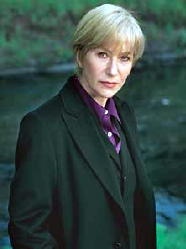
Trial and Retribution. [ghost written by Robin Blake, q.v.] Macmillan (London), 1997. TV movie [2 x 2 hour mini-series ]: La Plante, 1997 (scw: Lynda La Plante; dir: Aisling Walsh). SC: Det. Supt. Michael Walker (David Hayman) & Det. Insp. Pat North (Kate Buffery)
Trial and Retribution II. [ghost written by Robin Blake, q.v.] Macmillan (London), 1998. TV movie [2 x 2 hour mini-series]: La Plante, 1998 (scw: Lynda La Plante; dir: Aisling Walsh). SC: Det. Supt. Michael Walker (David Hayman) & Det. Insp. Pat North (Kate Buffery)
Trial and Retribution III. [ghost written by Robin Blake, q.v.] Macmillan (London), 1999. TV movie [2 x 2 hour mini-series]: La Plante, 1999 (scw: Lynda La Plante; dir: Jo Johnson). SC: Det. Supt. Michael Walker (David Hayman) & Det. Insp. Pat North (Kate Buffery)
Trial and Retribution IV. Novelization of TV series by Robin Blake, q.v., based on scripts by Lynda La Plante.
The Widows. Novelization of TV movie [6-part mini-series]: Euston/Thames, 1983 (scw: Lynda La Plante; dir: Ian Toynton). SC: Dolly Rawlins (Ann Mitchell). Also: TV movie [mini-series]: ABC, 2002 (scw: Lynda La Plante; dir: Geoffrey Sax). SC: Dolly Rawlins (Mercedes Ruehl)
The Widows II. Novelization of TV movie [6-part mini-series]: Euston/Thames, 1985 (scw: Lynda La Plante; dir: Paul Annett). SC: Dolly Rawlins (Ann Mitchell)
LARSON, GLEN A. Television writer and producer. Nominal co-author (with Roger Hill, q.v.) of five novelizations of the TV series Knight Rider. It is understood that Hill did all of the writing. The remaining four books were also based on individual one- or two-part episodes of the show; follow the preceding link for more information.
Knight Rider. TV movie: Universal, 1982 (scw: Tom Greene, Glen A. Larson; dir: Daniel Haller). SC: Michael Knight (David Hasselhoff)
LAURENSON, R. M. Author of three books listed in the (Revised) Crime Fiction IV, two of them from Phoenix Press (1948-1949) with series character Marc Jordan, a railroad attorney. The book below is the first of his two cases.
The Railroad Murder Case. Add setting: Illinois.
LEWIS, BEATRICE MARY Pseudonym: Lewis Iram, q.v.
LEWIS, MICHAEL (ARTHUR). British author of five detective novels between 1925 and 1931 listed in the (Revised) Crime Fiction IV. SC: Detective Insp. Anthony Field = AF. [Sergeant Hobbs was previously listed as being a series character in the two books marked *.]
* The Brand of the Beast. AF
* The Island of Disaster. AF
The Three Amateurs. AF
LEWIS, WILLIAM (L.) 1931- . Noted operatic tenor. Add year of birth and middle initial. In his one work of crime fiction included in the (Revised) Crime Fiction IV, listed below, five singers are the targets of a serial killer.
Gala (Dutton, 1987, hc) [New York City, NY; Theatre]
LOGAN, MALCOLM. Co-author with Carolynne Logan of one mystery novel included in the (Revised) Crime Fiction IV; see below. Delete previously stated birth & death dates, both tentative. Leading character: “Former boy prodigy” Justus Drumm.
One of These Seven. Mystery House, hc, 1946. [New York City, NY]
LONDON, JOAN. 1901-1971. Daughter of well-known author Jack London. Joint pseudonym with her husband Barney Mayes, 1905(?)-1978(?), q.v.: B. J. Maylon, q.v.
LONG, AMELIA REYNOLDS. Add settings for the mystery novels below; the series characters stated are already included in the (Revised) Crime Fiction IV:
The Corpse at the Quill Club. SC: Mystery writer Katherine “Peter” Piper; criminal psychologist Edward Trelawney. [Philadelphia]
Death Has a Will. SC: Attorney Steve Carter. [Pennsylvania]
The Lady Saw Red. SC: Katherine “Peter” Piper. [Pennsylvania]
Murder by Magic. SC: Steve Carter. [Pennsylvania]
Murder Times Three. SC: Edward Trelawney. [Philadelphia]
Murder to Type. SC: Steve Carter. [Pennsylvania]
LORAC, E. C. R. Pseudonym of Edith Caroline Rivett, (1894-1958); other pseudonym Carol Carnac. Prolific author of over 70 mystery novels under both pen names; her primary detective for the Lorac books is Chief Inspector Robert Macdonald. He is in the book below.
Murder by Matchlight. Add setting: London.
LORING, EMILIE. 1866-1951. [See the second comment below.] Most of this British author’s books were romantic fiction, published between 1922 and 1950; unfinished material discovered after her death was developed into an additional 20 romances (1952-1972). Add the title below.
Love Came Laughing By. Little, 1949 [Washington D.C.]
LOTTMAN, EILEEN
Welcome Home, Jaime. TV movie [two-part series pilot for The Bionic Woman]: Universal, 1976, as Welcome Home, Jaime (scw: Kenneth Johnson; dir: Alan Crosland). SC: Jamie Summers (Lindsay Wagner)
LOVELL, B(OYD) E. 1920-1962. Add full first name and year of death. Author of two mystery novels included in the (Revised) Crime Fiction IV, both with private eye Edge Hannagan.
(Mabel) DANA LYON. See joint pseudonym with (Josephine Hughston, q.v.) Dana Hughston, q.v. Note that Lyon and Hughston also shared a dual byline on the book cited below, previously included in the (Revised) Crime Fiction IV:
The Bathtub Murder (U.S.: Williams, 1933, hc)
